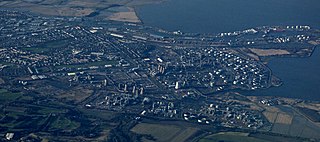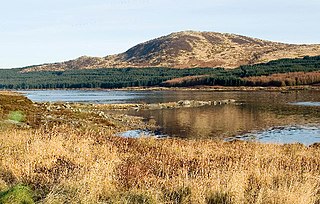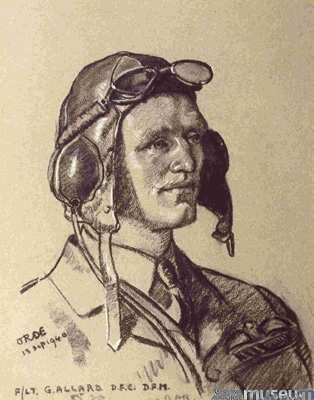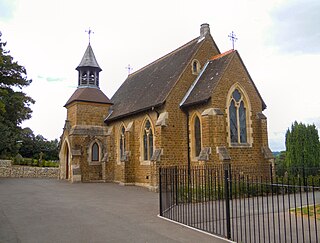
John Gillespie Magee Jr. was a World War II Anglo-American Royal Canadian Air Force fighter pilot and war poet, who wrote the sonnet "High Flight". He was killed in an accidental mid-air collision over England in 1941.

Falkirk is a town in the Central Lowlands of Scotland, historically within the county of Stirlingshire. It lies in the Forth Valley, 23+1⁄2 miles northwest of Edinburgh and 20+1⁄2 miles (33 km) northeast of Glasgow.

Grangemouth is a town in the Falkirk council area, Scotland. Historically part of the county of Stirlingshire, the town lies in the Forth Valley, on the banks of the Firth of Forth, 3 miles (4.8 km) east of Falkirk, 5 miles (8.0 km) west of Bo'ness and 13 miles (20.9 km) south-east of Stirling. Grangemouth had a resident population of 17,906 according to the 2001 Census. Preliminary figures from the 2011 census reported the number as 17,373.

Polmont is a village in the Falkirk council area of Central Scotland. It lies towards the east of the town of Falkirk, north of the Union Canal, which runs adjacent to the village.

Linlithgow and East Falkirk is a county constituency of the House of Commons of the Parliament of the United Kingdom, created for use in the 2005 general election. It replaced most of Falkirk East and Linlithgow.

The Glasgow Necropolis is a Victorian cemetery in Glasgow, Scotland. It is on a low but very prominent hill to the east of Glasgow Cathedral. Fifty thousand individuals have been buried here. Typical for the period, only a small percentage are named on monuments and not every grave has a stone. Approximately 3,500 monuments exist here.

Loch Doon is a freshwater loch in Carrick, Scotland. The River Doon issues from its northern end, while the loch itself receives waters from Gala Lane and Loch Enoch via Eglin Lane.

The Cannock Chase German Military Cemetery is on Cannock Chase, Staffordshire, England. The cemetery contains nearly 5,000 burials from both the First and Second World War. The burials are mainly German and Austrian nationals with a very small number of Ukrainians.
Royal Air Force Grangemouth or more simply RAF Grangemouth is a former Royal Air Force station located 3 mi (4.8 km) north east of Falkirk, Stirlingshire, Scotland.

Harrogate (Stonefall) Cemetery is a Commonwealth War Graves Commission (CWGC) burial ground for the dead of the First World War and Second World War located on the outskirts of Harrogate in North Yorkshire, England.

Queen's Road Cemetery is a cemetery in Croydon, England. It opened in 1861, and was followed in 1897 by the larger Croydon Cemetery in Mitcham Road. Both cemeteries are now managed by the London Borough of Croydon.

Flight Lieutenant Geoffrey "Sammy" Allard & Bar was a Royal Air Force (RAF) flying ace of the Second World War. Allard scored 19 victories against enemy aircraft, as well as five shared kills and two probable kills, during the war.
Joseph Inkerman Johnson was born in 1914 in Hulcote, Northamptonshire. He joined the RAF in June 1935 as an Aircrafthand (Carpenter). He was later remustered as an Airman-in training Pilot and won his wings on 11 August 1939 — three weeks before Britain declared war on Germany.

Royal Air Force Balado Bridge or more simply RAF Balado Bridge is a former Royal Air Force station located 2 miles west of Kinross, in central Scotland. It opened in 1942 as a satellite airfield to RAF Grangemouth, and closed in 1957. It has since served as a NATO satellite station, a microlight flying base, and as the venue for the T in the Park music festival.

Rosebank Cemetery is a 19th-century cemetery in Edinburgh. It is located at the junction of Pilrig Street and Broughton Road in the Pilrig area, close to the historical boundary of Leith. The cemetery is protected as a category C listed building.

The Dunbeath air crash involved the loss of a Short S.25 Sunderland Mk. III that crashed in the Scottish Highlands on a headland known as Eagle's Rock near Dunbeath, Caithness, on 25 August 1942. The crash killed 14 of 15 passengers and crew, including Prince George, Duke of Kent, who was on duty as an Air Commodore in the Royal Air Force on a mission to Reykjavík; a message of condolence was proposed in Parliament by the British Prime Minister. A Royal Air Force Board of Inquiry determined that the crash was the result of a navigational error by the crew.

Bideford Higher Cemetery is the burial ground for Bideford in North Devon. Today it is managed by Torridge District Council.

Wellshill Cemetery is a 19th-century cemetery in the Scottish city of Perth, Perth and Kinross. Located on Feus Road, the cemetery is still operational and is under the control of Perth and Kinross Council.

Green Lane Cemetery is a small cemetery on Green Lane in Farnham in Surrey, one of four cemeteries owned and maintained by Farnham Town Council.
The Falkirk Braes is a geographical and sociopolitical entity within the Falkirk local authority area in Scotland. The population is approximately 32,000 (2018), about 20% of the total for Falkirk council area.

















